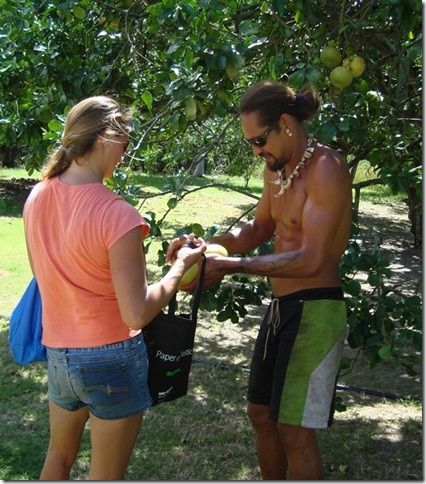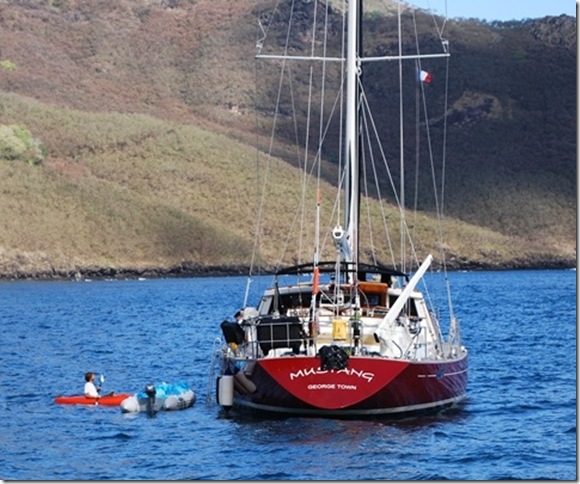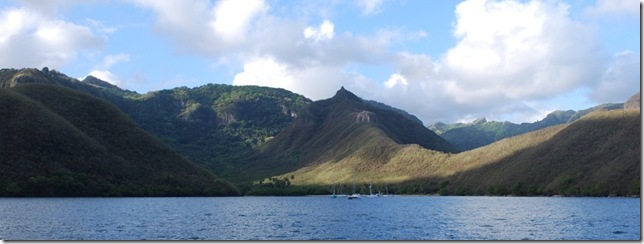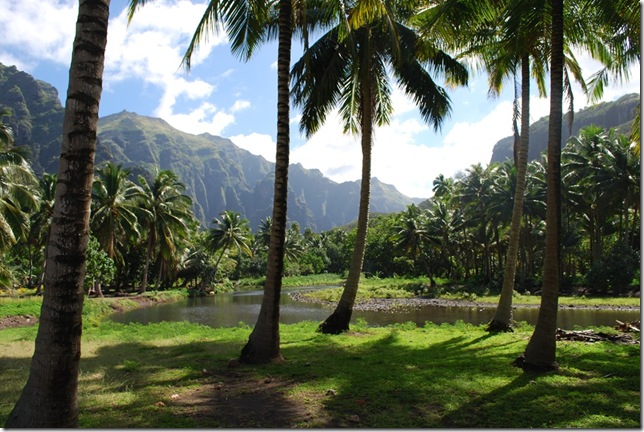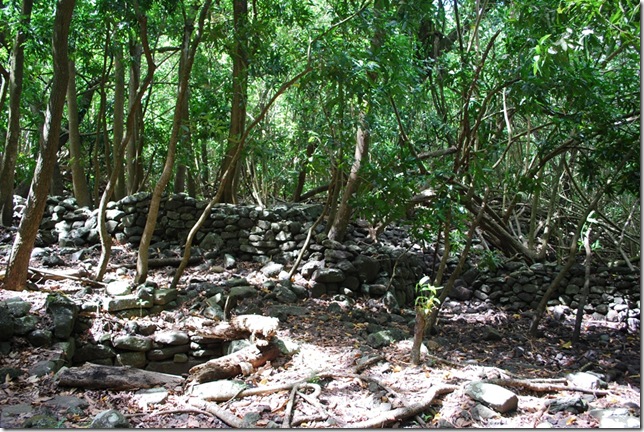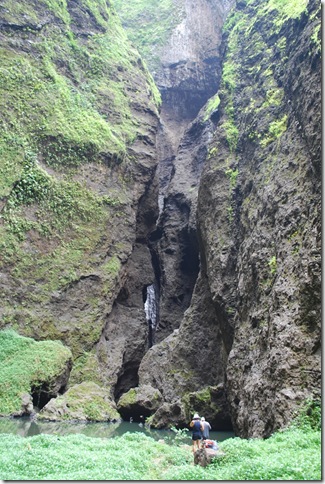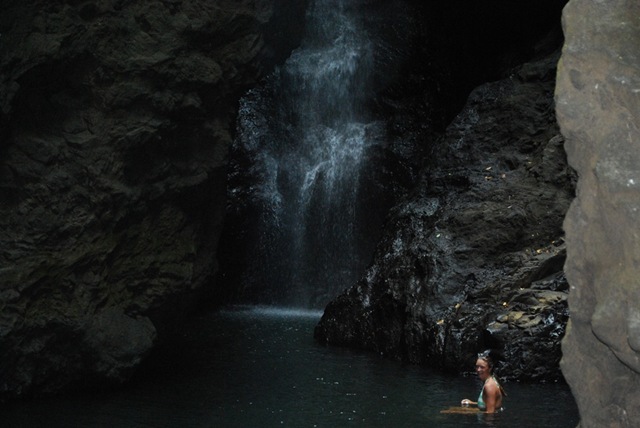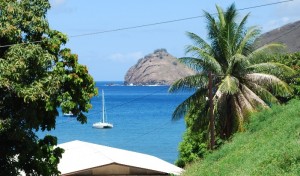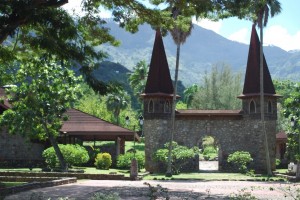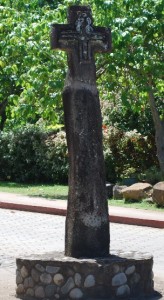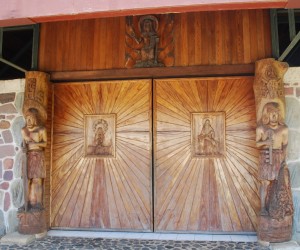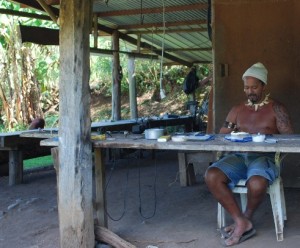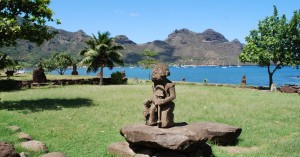Lat: 15 29.856′ S
Lon: 144 29.348′ W
The last few days have been some of the calmest sailing we’ve seen yet. The winds are light, so our speed hasn’t been great, but there’s hardly a whitecap in sight, and the days are sunny and beautiful. The wind has slowly clocked toward the northeast a bit, so we’re using a spinnaker to run downwind. The spinnaker we usually fly has a tear in a trim piece, so we’re using our other spinnaker, which is green and white. It’s a bit smaller and slightly asymmetrical (an intentional design feature to make it easier to fly when not going straight downwind), but is staying set pretty well in the light wind.
On the negative side, the main halyard chafed through again. This time the 1/4″ stainless steel wire rope I spliced in at the end of the halyard actually chafed through! It was still running through a block outside the mast, which doesn’t look like it’s going to be a feasible approach. Hopefully in Tahiti I can get a longer piece of wire, splice it back into the halyard, and try it again. There’s got to be some solution that will work.
With such calm seas, there wasn’t much adjusting to do, so we’re all pretty well settled in. New Zealand radio comes in pretty well, so we’ve been able to listen to news shows, which we’ve appreciated. There was a news piece on today about a Kiwi member of parliment who’s caught a bit of heat from the press for having the most travel expenditures ($67k NZ year-to-date). He’s promised to get around by hitchhiking for a while to cut costs and get to know his constituents better. That’s good stuff. Lauren and I have been spending some time with a sudoku book that she found in Panama (the Spanish-language crossword puzzle books weren’t going to work), and we’ve all enjoyed making a passage with less motion than some of the anchorages we’ve been in.
Aside from the usual reading, I’ve been able to start some work on the boat as well (yeah, I am actually a little bored). We haven’t ever had a working knotmeter (speedometer), but we have a spare on the boat, so I took a look at things. The GPS can tell us what our speed over ground is, but without a knotmeter (which gives your speed through the water), we don’t know the strength of the current, which can be nice at times. The previous owner said the transducer just needed a new impeller, but in typical fashion (a) that wasn’t true at all, the transducer was shot, and (b) the transducer wasn’t even connected to the display. I looked into a new transducer before we left, but everyone standardized on through-hull diameter at some point since ours was initially installed and the size they chose was a bit larger in diameter (and our old version is long since obsolete), so to put a new one in we’d have to put in a larger through-hull (make the hole in the boat bigger) — not really do-able while you’re on the move. Luckily, although it’s a slightly different design, the spare is the correct diameter and doesn’t seem to leak when it’s installed. Even though it doesn’t have any documentation, I was able to figure out the wiring and it looks like we should have a knotmeter and water temp sensor later today.
It looks like we’re going to try stopping at two of the Tuamotus — Kauehi and Fakarava. The Tuamotus are a string of atolls running northwest-to-southeast between the Marquesas and Tahiti. While the Marquesas are relatively young and high volcanic islands with only one bay having a coral reef, the Tuamotus are old volcanic remnants — the peak of the volcano has sunk back into the sea and all that’s left is the fringing barrier reef, which is present in the form of small coral islets (motus) of shallow reefs that mark where the barrier reef of the old island used to be. In between the newer Marquesas-style high island with no reef and the atoll are most of the Society islands, including Tahiti and Bora Bora, which have a high island surrounded by a fringing reef that creates an encircling lagoon. The atolls are all lagoon, and when the tide goes out, almost all of it runs through the one or two small passes into the lagoon. Imagine the water level in 50-200 square miles of lagoon dropping by several feet over the course of 6 hours or so and all having to run through a couple of small passes — the current in the smaller passes can exceed our cruising speed of 6 knots under power! In order to avoid having to time the tide and associated current, we’re going to try stopping at a couple of atolls with larger passes. We are hoping to be able to dive one of the passes, as watching the marine life funnel in and out is supposed to be amazing. We may also get our first encounter with sharks as well — the slogan of the dive shop on Fakarava is “every dive without a shark is free.”
The nights have been beautiful as well. The moon is starting to wane, but is still so bright that you can easily read during your watch by moonlight; it hurts your eyes to look directly at it. We’ve seen a few ships, which is a change from the Galapagos-Marquesas crossing, where the signs of mankind totaled one loose orange buoy and one floating pair of pink underwear in 22 days.
Lauren’s mourning our dwindling list of ingredients for meals, but we’re still eating pretty well. A couple of days ago I opened a coconut and we had fresh coconut and homemade granola with powdered milk for breakfast. Last night we enjoyed homemade pizza, although the funny no-refrigeration cheese doesn’t melt too well (I guess whatever French word gets translated as fondue doesn’t really mean melting cheese). We have potatoes and eggs from Nuku Hiva, so Wes & Tiff made a traditional scrambled eggs & potatoes breakfast this morning. Pasta & sauce or rice & something shows up every day or two, and when we’re near a store here in French Polynesia, there’s always baguette with cheese and cucumber or tomato.
This afternoon, Lauren spotted a spinnaker behind us on her watch, and minutes later a call for “the sailboat flying a green spinnaker” came up on channel 16. We answered and had a nice chat with a Kiwi boat called “Alpha Cruces” (after the brightest star in the southern cross) that’s been out sailing for 4 years. They left the Galapagos headed straight for Tahiti — we were the first boat they’d seen in 23 days. Like other Kiwis we’ve talked to that have been around the world, seen most of the Pacific, and are finally headed home, they’re biting off some long Pacific passages to get home soon. In all our travels, we have yet to hear a bad report on New Zealand, so we’re really looking experiencing it ourselves.
12 19.000′ S
142 19.075′ W
We have returned to the quiet and solitude of the Pacific tradewind belt. Our last couple of days in the Marquesas seem quite busy by comparison. As Dallas described, the hike to the waterfall at Daniel’s Bay was magnificent. What’s more, swimming in the cold (but somehow still comfortable), crystal-clear freshwater pool, nearly surrounded on all sides by immense volcanic rock, ranks near the top of our list of things to do in the Marquesas.
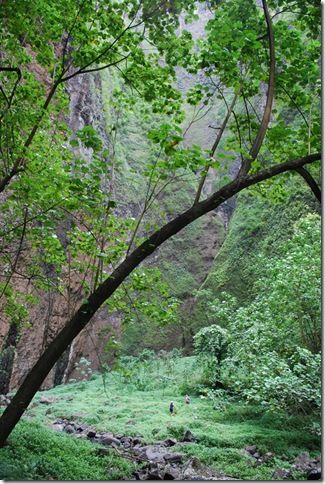 Verdant canyon near the waterfall
Verdant canyon near the waterfall
Shortly after we arrived at the waterfall, we were joined by a cruising couple aboard S/V Alethia Ann who we had never met but quickly befriended. We invited them aboard for a drink on Wednesday night and found them to be delightful company. Like Dallas and I, they are happy newlyweds, but unlike us, they come from different places and times. She is a young and exuberant retail clerk from Thailand, while he is an older English ex-pat who was a pilot for many years. In addition to building two houses in the Caribbean, he built their boat (which took longer), an unusual square-rigged, 48′ monohull that he has sailed across the Atlantic three times. Their boat only sails at 3 or 4 knots top speed due to its heavy load, so they had allotted 6 weeks for the Galapagos-to-Marquesas passage! Fortunately, it only took them 29 days. Let’s hope that they have similar luck throughout the Pacific, as they are making a beeline to north Australia in an effort to beat the cyclone season. Provided the Somali pirate situation improves (allowing us to stick with our original route), we will see them again at their new home in Thailand.
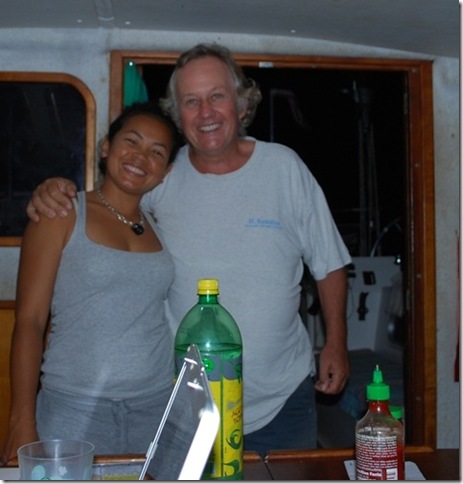 Pek and Barry aboard Pura Vida
Pek and Barry aboard Pura Vida
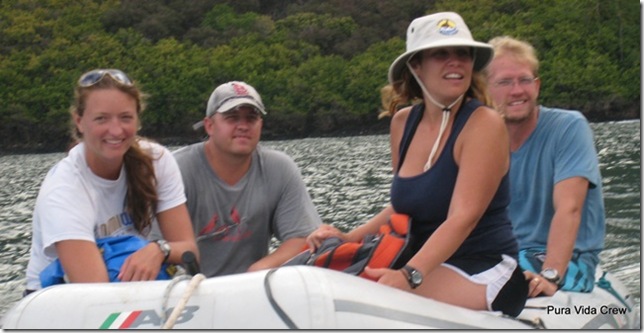 Getting a tow back to the boat from Pek and Barry
Getting a tow back to the boat from Pek and Barry
I think we all could have spent several days in Daniel’s Bay enjoying the pool as well as the verdant feast-for-the-eyes offered by the surrounding cliffs and forest trail, but we, too, have to watch the calendar. As it turned out, we spent an extra night there, but it was out of necessity, as Dallas attempted to use the generator to equalize the house batteries. This, I am told, was long overdue in that their capacity was greatly depleted, but since we have been spoiling ourselves with the use of computers, stereo, fans, etc., it took the entire day just to bring the batteries back to baseline. By the time we were in super-charge mode, there was less than an hour left before neighbors would have been heading to bed, not long enough to have much of an effect on our overall capacity, so I’m sure we will be trying again soon.
While Dallas dealt with the electrical system, Wes, Tiff, and I jumped in the dinghy (using the outboard motor this time) and headed back to the adjacent bay to fill our jugs with the "best water in the world" and take our meager offering to the woman that had loaded us up with fruit the day before. Tiff and I went to see her while Wes got started filling water. First I showed her the baguette that I had brought despite that it represented a good part of our limited bread supply for the passage to the Tuamotus. Immediately she rejected it. I had better luck with a large jar of jelly (purchased in Panama), but that’s when things kind of stalled out. She accepted a men’s t-shirt, a package of unopened duct tape, and a new can of WD-40, but it was clear that she was not impressed with any of these items. Admittedly, we got the better end of the deal, but we simply did not have the cigarettes and jewelry ("no small earrings, big ones!") that she desired.
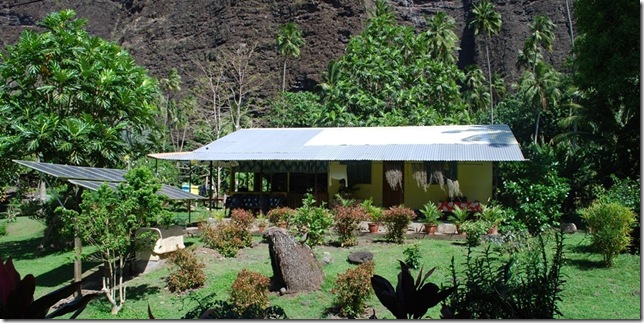 The home of Monette, the professional barterer
The home of Monette, the professional barterer
It was pretty evident that we needed to be trading with someone more likely to identify with our financial situation (i.e., poor). We found him on the beach of Daniel’s Bay. He was a younger (30-something) man with long hair tied back and no shirt on, revealing a large tattoo and a sharks’ tooth necklace. When I asked if he had pamplemousse, he smiled and promptly walked us over to his tree of plenty. He sort of chuckled when I told him we had a little bit to trade as if this was not so important. After loading us up with 13 large fruit, he asked if we wanted more, but I told him that was plenty, thanked him profusely, and awkwardly handed him a hot pink gift bag (it was the only one I had on the boat!) full of canned corn beef, candles, tea, chewing gum, and canned peas. After seeing his house, I think he might appreciate at least some of the goods. He lived in an open-air abode that he built himself and decorated with animal bones, a Jack Daniel’s bottle used for candles, and a Bob Marley poster. We were so impressed with his generosity that we intended to make some cookies for him once back on the boat, forgetting that that required electricity, which we did not have use of while the generator was running. (We have an electric solenoid valve connected to our propane tank.) Oh well. He knew we were grateful.
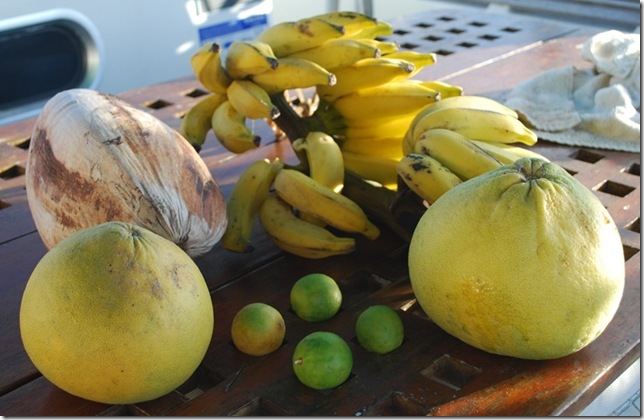 Assorted fruits from Daniel’s Bay
Assorted fruits from Daniel’s Bay
We awoke early on Friday, lifted anchor, and motored out into calm seas. It was a beautiful day, and we took some parting shots of the Marquesas Islands. We hadn’t planned to stay there quite so long (almost a month) but don’t regret a day of it (OK, maybe the day I spent in bed with heat rash). Now it’s only 500 or so miles to the Tuamotu ("many islands" in Tahitian) Archipelago, a group of 76 coral atolls barely above sea level. This would have been our longest passage ever just a few months ago but now seems like a short, pleasant hop. The days are flying by thanks to good books, and the nights have been gorgeous starting with the rising of the orange, nearly-full moon on the horizon around 8:30 p.m..
The big news this morning was that the partial stalk of bananas that we pulled off a tree (from an uninhabited location, mind you) in Taipivai had turned yellow at last. (After a week passed, we were beginning to wonder if they couldn’t ripen off the tree.) They are now almost gone; the little bananas grown here are irresistible.
We are sailing under the main and jib at around 5 knots on average; at this rate, we should arrive at the archipelago on Tuesday. Unlike previous landfalls, we will not be able to see the islands until we are very close. We will then have a somewhat narrow and likely very shallow channel to navigate into a lagoon. We are all excited to experience a new type of island, especially one that will compel us to break out the scuba gear!
Before we left Taiohae Bay, a cruising friend of ours stopped by to say hello. After making the passage from the US with his girlfriend, he’s now single-handing. Her plane took off from Nuku Hiva while we had lunch with him and talked over plans for the next few months. He’s on his way to New Zealand as well but is first heading to Eiao, an uninhabited island 30 miles north to join a boat of almost penniless young Europeans who are going to attempt to catch some wild goats and pigs without hunting weapons. It sounds as though he is definitely ready for some adventure! Nonetheless, he was well aware of the disadvantages of going it alone, and we thought we might be able to help.
Lauren and I had talked for a couple minutes with a really nice Canadian guy on the dock who had crewed on a beautiful 83′ yacht from San Francisco to Nuku Hiva after seeing the boat in Canada and asking the owner if he needed crew. The owner’s friends and family were due to join him, so Mark’s (the Canadian) gig was over, but he was doing it for experience and board and didn’t seem too eager for the adventure to end. We recommended to our cruising friend that he stop by the yacht and ask if Mark would be interested in joining him for a while. On our way out of the bay, we motored past them as they were talking and later heard on the radio that Mark had agreed to join up with our friend for a while. That was good news for all and yet another interesting tale of "How I came to sail the South Pacific" in the making.
Paul (in the kayak) and Mark talking it over
Daniel’s Bay, whose real name is Hakatea and it’s sister bay Hakaui are famous for two things. The first is Daniel, who is now dead, but earned quite a reputation for his friendliness and generosity with cruisers. He apparently had a legendary guestbook that was signed by many well-known sailors, and he was even kind enough to install a buoy in the bay with a fresh water hose run from the shore that allowed cruisers to fill their water tanks with the "best water in the world" without ever lugging a jug. The other bay, Hakaui, is also home to some very friendly Marquesans as well and is famous for a 900 foot waterfall that everybody hikes to see.
Daniel’s Bay
We started our hike about 10 in the morning after doing some laundry and a couple boat tasks. Wes pulled out a couple spare oars that we have and all four of us paddled over for some exercise. The beginning of the walk is through a beautiful area that the residents have cleared and planted. There are open-air houses and work buildings scattered by the valley road between the river and mountain. Cultivated trees and plants of numerous types are everywhere — banana, coconut, lime, pamplemousse, noni, papaya, mango, edible roots, and flowering bushes. We’d been ashore less than two minutes when Monette asked us if we’d like bananas. We answered with an enthusiastic yes, and she told us stop by after visiting the waterfall.
View from the beach back into the waterfall valley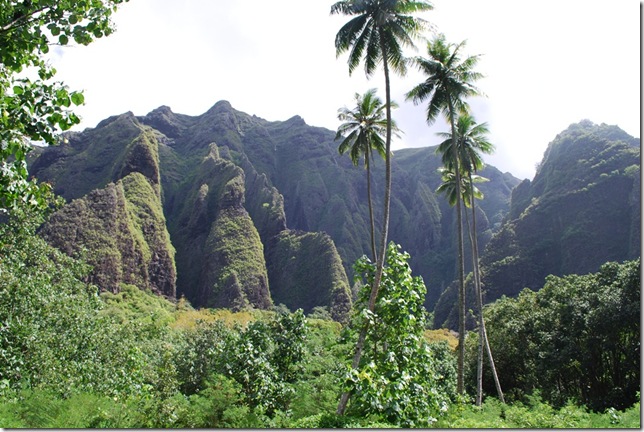
View during the walk to the wooded area
The walk to the waterfall is an unforgettable one. Our photographed cruising guide says it’s 1800 meters, but it took us almost two hours each way. The road begins as a truck path through the inhabited portion of the valley, then crosses a stream and turns into a trail. For the remainder of the walk, one is almost never out of sight of ancient ruins. Almost the entire walk is on or near an ancient stone road. After walking on and on along the ancient road with occasional stone platforms off to the side where houses or other buildings had stood, the size and sophistication of the old population begins to sink in. There were thousands in just this valley, where now less than 50 live. They built stone structures that would be unthinkable today without heavy machinery, and nearly all of them died less than 200 years ago, primarily as the victims of European germs.
After crossing the first stream, the path enters the forest beside the stream where it wanders for quite a while until it finally finds its way back to a clearing at the edge of the stream. The clearing was apparently the site of a large village, because even now very little brush grows over the stones. There are clearly walls, and paved areas as well as several square stone pits which were apparently used for storing food. At the edge of the stream, the steep and beautiful mountains again become visible. They rise almost vertically to a height of nearly 1000 feet and are covered sparsely with bright green foliage. They are so monolithic have such large folds and features that only when the white birds flying high overhead come near the peaks and turn into tiny white specks do you realize how large they really are.
Ancient ruins near the river with a food pit in the left foreground
After crossing the stream a second time the path leads into a verdant canyon walled by the high mountains. At the end of the canyon there is a pool fed by the waterfall and we all had a swim in the cool water. Most of the waterfall itself is hidden behind a fold in the cliff, but after climbing over some large rocks and swimming across another pool, you can tread water directly underneath the crashing spray as it falls the last 20 feet or so into the pool. The end of the valley is a place you want to linger, and picturesque as the ocean views are here, you can appreciate why so many people lived in the deep reaches of the valley, with the stream rushing over the boulders and the mountain cliffs towering overhead.
The waterfall and outer pool 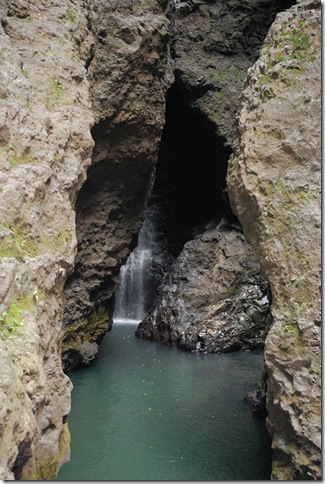 The inner pool
The inner pool
Lauren after her waterfall shower
Monette was waiting for us when we got back. She was doing yard work with her husband and son, but quickly shed her flip-flops and led us toward the house. A lot of yachties make the walk to the waterfall and she’s ready for them. She picked limes for us, handed us a stalk of bananas from among the several that were hanging from bark ropes behind the house, and gave us pamplemousse from the stack on her kitchen counter. Her house doesn’t have windows, so we conversed for a while standing outside while she was in the kitchen. It was clear she wanted to trade, so we started trying to figure out what she wanted — no to canned corn beef, small ear-rings, and used t-shirts, and yes to new t-shirts, large ear-rings, jelly, and cigarettes (but we don’t have any of these things except for jelly). After the trade discussion, she handed us half a dozen starfruit, and we headed back to the boat. Today we take the dinghy back to bring our side of the trade. We’ll probably try to trade for some more pamplemousse with the people in Daniel’s Bay as well, as we heard they’re going for $3 each in Tahiti.
Walking the capital city from end to end takes about 30 minutes. We tried stopping at the gendarmerie to check in. Although we were there on one of the three mornings that they deal with boats, they were out temporarily (I saw them wondering around the building where the art is sold, but thought someone else would be manning the station) so we’ll probably leave Nuku Hiva without checking in.
Apparently Catholic priests were the first missionaries to Nuku Hiva, as they got the prime real estate across from the mouth of the bay and atop the traditional religious site. There’s a monument at the intersection that leads to the Catholic complex that is reportedly on the site where human sacrifices used to occur. Upon abandoning their old religion, the locals built the new monument, but topped it with a clearly recognizable member of the male anatomy. Being conspicuously situated between the church and the bay, this was not exactly consistent with the priest’s sensibilities. Today, you can see a phallic-looking monument with a very old stone cross cemented to the top. The old church itself is gone, except for the facade, and a beautiful new church is built beside it. Beginning with the monument at the street, the mixture of the two religions is evident. The locations are the same. The stone road leading to the old church has tattoo rocks and ancient stones for grinding tools built into the pathway all the way to the door of the church. In the back is a shrine to the pope guarded by two tikis and featuring a pontiff with a Marquesan cross instead of the typical Christian crucifix. The door of the church is beautifully carved and also contains motifs that mix the two traditions. Inside, instead of stained glass windows, the church has open-air space between the stone walls and roof with wrought iron in the shape of Marquesan crosses and the Christian fish. The Biblical scenes usually depicted in the stained glass windows or paintings hung on the wall have been illustrated by monolithic wood carvings of the same stories.
Farther down the street was a large marae area with stone carvings that apparently was built in the last 20 or 30 years in the style of the ancient sites. There is a carver’s shed nearby where local artisans are welcome to come and work at carving wood and bone. Plenty of raw material was lying around, but only one carver was there when we stopped by. He was working on a couple of very beautifully carved pig tusks that were going to be the centerpiece of necklaces. The tusk was beautiful, but at $250, was a little out of our price range. He did tell us about a museum, so we kept walking along to the other end of town.
The museum and boutique is run by an American named Rose who sailed here from California with her husband 31 years ago. She told us he had opened the Marquesas for tourism, but she had unfortunately lost him about 15 years ago. She stayed on, collecting and documenting artifacts of historical significance, selling local art in her boutique, and building and running the hotel they had been working on together. She has a book on the Marquesas that she has nearly finished and is about to start happy hour up again at her hotel that will serve as the only yacht club in the islands. She had a great story for us about a TV show that 48 Hours did a a few years back. It was during a miserable US winter, and the show featured places you could go to get away. Her hotel was one of the places, and the bar was packed with yachties for happy hour. One American with a German accent agreed to an interview, and the next week a call came in that his wife back in the states had recognized him. It seems he had been missing for two years and officially declared dead.
After stocking up with fresh veggies at the farmer’s market, we made a dinghy trip to the local gas station on the edge of the bay, where we were able to dump our old gas and buy new. At 140 CFP per liter, we got about 11 gallons for around $80, not exactly a bargain. Our water tanks are now topped off as well, and we’re likely headed to Daniel’s Bay this afternoon, which will be our last stop in the Marquesas.
Lauren and I ended the day with dinner at the Moana Nui (Big Ocean) Hotel, which has the only wood-fired pizza oven in the Marquesas. The salad and pizza were great, but we made the mistake of getting the vegetarian pizza without asking what the topping “du jour” were. So, while I looked over the sign advertising pizzas with mushrooms, tomatoes, olives, and onions (which I love), we ate a pizza topped with heavy helpings of cabbage, shredded carrots, green beans, cucumbers, three olives, and tomato. You could visit all of the stores in town in about half an hour, and they’re all supplied by the same boat. Having just been to the store, it was clear that the vegetables du jour were the cheapest on the island, but they were plentiful and the pizza was otherwise excellent.
With its cool night air and nice breeze, Haaga Haa Bay (Tai Pi Valley) enticed us to stay another night, the last of July. We now have three months until we set sail for New Zealand at the beginning of November to avoid the summer cyclone (hurricane) season in the western South Pacific. We’ve met one single-hander in Ua Pou who was half-heartedly trying to make Australia and the Torres Strait by October, but everyone else we’ve talked to since Panama is either staying in the South Pacific or headed to New Zealand for the season, with the majority choosing New Zealand.
Our Plan A was to make Australia by October after crossing the Pacific and then to proceed on across the Indian Ocean, but repair delays led us to choose to spend the season in New Zealand instead so that we could enjoy the South Pacific at a slower pace. Our current plan is to leave the Marquesas in the next few days and stop in the Tuamotus on the way to Tahiti, which is about 750 miles from here. From Tahiti, there are several more of the Society Islands (Bora-Bora being the most well-known) to visit before finally leaving French Polynesia. West of French Polynesia are the Cook Islands, followed by the small, one-island nation of Niue and the the northern Tonga islands. If we make it past Tonga before heading to New Zealand, Fiji, Samoa, and the islands of Wallis and Futuna are all options.
The motorsail from Haaga Haa Bay to Taiohae Bay only took a couple of hours and included the beautiful views typical of the Marquesas. The cluster of three bays we had been anchored in was especially steep-walled and picturesque in its ruggedness.
Taiohae Bay is the capital of the Marquesas and its largest “city” at about 1800 or so. That’s small by American standards, but it does have a bit of a big city feel to us at this point. There are actually several tourist and boat-related businesses on the dock. Although there is no marina here, there are 20 or so boats anchored around the bay, including some pretty large sailboats. The main road along the beach is busy enough that people walk on a path beside the road instead of on the road itself for a change. The bay itself is very large, U-shaped, and open to the south. Like most of the bays here, it was once the crater of a volcano. We generally don’t set a stern anchor unless the anchorage is tightly packed, so we’re anchored away from the side of the bay where the dock is and closer to the middle of the bay, across from the east edge of the mouth. In addition to having room to swing without being near other boats, I was hoping we’d be more exposed to the breeze here. Unfortunately, although there typically is a breeze, it’s often blowing across the beam of the boat, which is being oriented by the tidal current as much as the wind, and doesn’t cool things as well down below.
We spent most of yesterday afternoon and today enjoying our first reliable, high-speed internet connection since the Galapagos. We had a chance to Skype with friends and family, and it was good to hear their voices for the first time in 6 weeks or so. We definitely enjoy taking advantage of the advances of just the last 10-15 years that allow a video conference between the US and our boat anchored here in a bay on Nuku Hiva. While we were talking, we could hear a Sunday sing-along type of event that sounded like a larger version of the one we found in Hakahetau last Sunday. The harmonizing voices, quickly-strummed ukuleles, and rhythmic pahus carried out over the bay from a public building on the hillside for several hours. We read in a cruising guide that the people of the South Pacific love to sing, and it’s true. They also love the guitar and ukulele, and we often see them passing one around and teaching each other a chord or song. Although bands for more formal entertainment may feature a keyboard and electric guitars, the more informal and traditional singing that we’ve seen has all been done with just the ukulele, guitar, and pahu. It’s common for anyone sitting nearby to suggest or start a song and for instruments to change hands occasionally when someone is inspired or gets up for a break.
I also downloaded the weather forecast today and found that our days of beautiful, consistent tradewind sailing are numbered. Jimmy Cornell’s book says as much, but seeing the GRIB data overlaid on a chart brought things home. On the way to Tahiti we’ll enter a region that is far enough south to be impacted by fronts south of the trades. We’ll also be entering the South Pacific Convergence Zone (SPCZ), which I’m not extremely conversant with, but is basically a region that allows non-tradewind weather like winds from the west, low pressure regions, etc. It looks like we’ll be back to watching the weather.
The boat has been doing pretty well lately, so we shouldn’t have much to do to get ready for the passage to the Tuamotus, although we definitely need to get some fresh gasoline. We hadn’t had the need to fill the dinghy’s outboard engine since Key West and found out two days ago that the gas in our jerry jug is bad. It’s making the outboard smoke, dumping fuel with the exhaust, and will only run with the choke open, so we’re going to pick some fresh stuff up tomorrow.
Even with all of the motoring and motorsailing we’ve been doing between bays here, we’ve only put 40 hours or so on the two diesel engines combined since we left the Galapagos. Anchorage-to-anchorage, our 3000 mile passage to Hiva Oa only used about 3 gallons of diesel, which is probably the best “mileage” I’m ever going to get.


